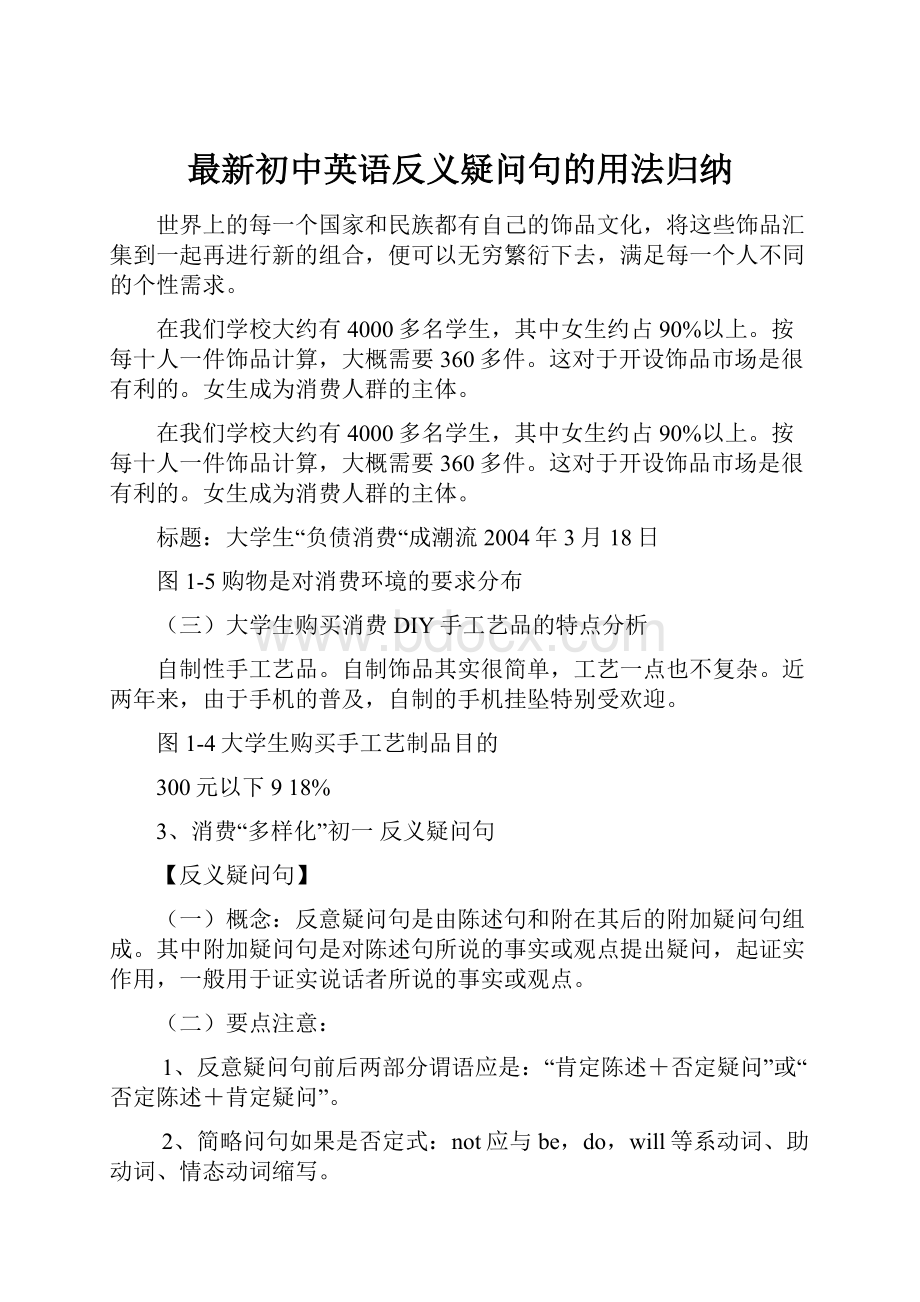最新初中英语反义疑问句的用法归纳.docx
《最新初中英语反义疑问句的用法归纳.docx》由会员分享,可在线阅读,更多相关《最新初中英语反义疑问句的用法归纳.docx(13页珍藏版)》请在冰豆网上搜索。

最新初中英语反义疑问句的用法归纳
世界上的每一个国家和民族都有自己的饰品文化,将这些饰品汇集到一起再进行新的组合,便可以无穷繁衍下去,满足每一个人不同的个性需求。
在我们学校大约有4000多名学生,其中女生约占90%以上。
按每十人一件饰品计算,大概需要360多件。
这对于开设饰品市场是很有利的。
女生成为消费人群的主体。
在我们学校大约有4000多名学生,其中女生约占90%以上。
按每十人一件饰品计算,大概需要360多件。
这对于开设饰品市场是很有利的。
女生成为消费人群的主体。
标题:
大学生“负债消费“成潮流2004年3月18日
图1-5购物是对消费环境的要求分布
(三)大学生购买消费DIY手工艺品的特点分析
自制性手工艺品。
自制饰品其实很简单,工艺一点也不复杂。
近两年来,由于手机的普及,自制的手机挂坠特别受欢迎。
图1-4大学生购买手工艺制品目的
300元以下918%
3、消费“多样化”初一反义疑问句
【反义疑问句】
(一)概念:
反意疑问句是由陈述句和附在其后的附加疑问句组成。
其中附加疑问句是对陈述句所说的事实或观点提出疑问,起证实作用,一般用于证实说话者所说的事实或观点。
(二)要点注意:
1、反意疑问句前后两部分谓语应是:
“肯定陈述+否定疑问”或“否定陈述+肯定疑问”。
2、简略问句如果是否定式:
not应与be,do,will等系动词、助动词、情态动词缩写。
3、简略问句的主语不用名词,应用人称代词。
4、陈述部分含“too...to”时,是否定句。
(三)用法:
1)陈述部分Iam时,疑问部分要用aren'tI.
I'mastallasyoursister,aren'tI?
(我和你姐姐一样高,对吗?
)
2)陈述部分用no,nothing,nobody,never,few,little,seldom,hardly等否定含义的词时,疑问部分用肯定含义。
如:
Theoldmanmadenoanswer,didhe?
Jimisneverlateforschool,ishe?
3)陈述部分有情态动词
haveto+v.(hadto+v.),疑问部分常用don't+主语(didn't+主语)。
Wehavetogetthereateighttomorrow,don'twe?
usedto,疑问部分用didn't+主语或usedn't+主语。
Heusedtotakepicturesthere,didn'the?
/usedn'the?
hadbetter(最好)+v.疑问句部分用hadn'tyou?
You'dbetterreaditbyyourself,hadn'tyou?
4)陈述部分有wouldrather(宁可、宁愿)+v.,疑问部分多用wouldn't+主语。
Hewouldratherreadittentimesthanreciteit,wouldn'the?
5陈述部分有You'dliketo+v.疑问部分用wouldn't+主语。
You'dliketogowithme,wouldn'tyou?
6)陈述部分主语是指示代词或不定代词everything,that,nothing,this,疑问部分主语用it。
Everythingisready,isn'tit?
陈述部分主语是不定代词everybody,anyone,somebody,nobody,noone等,疑问部分常用复数they,有时也用单数he.
Everyoneknowstheanswer,don'tthey?
(doesn’the?
)
Nobodyknowsaboutit,dothey?
(doeshe?
)
7)think引导的宾语从句:
A.主语是第一人称
Idon'tthinkheisbright,ishe?
Webelieveshecandoitbetter,can'tshe?
B.如果主语不是第一人称则疑问部分与主句相对应构成反意疑问句
Hethoughttheywerewrong,didn'the?
(不能说weren'tthey?
)
8)省去主语的祈使句的反意疑问句,疑问部分用willyou。
Don'tdothatagain,willyou?
Gowithme,willyou/won'tyou?
Let's开头的祈使句,后用shallwe(或用shan'twe)?
而Letus开头的祈使句,后用willyou(或won'tyou)?
Let'sgoandlistentothemusic,shallwe(或用shan'twe)?
Letuswaitforyouinthereading-room,willyou(或won'tyou)?
9)陈述部分是"therebe"结构的,疑问部分用there。
Thereissomethingwrongwithyourwatch,isn'tthere?
Therewillnotbeanytrouble,willthere?
10)否定前缀不能视为否定词,其反意疑问句仍用否定形式。
Itisimpossible,isn'tit?
Heisnotunkindtohisclassmates,ishe?
例题
()1.Don’tforgettogivePollysomefoodandchangeherwater,_______?
A.shallweB.willyouC.won’tyouD.doyou
()2.Thereislittlejuiceintheglass,_________?
A.isthereB.isn’tthereC.isit
()3.---He’sseldomlateforschool,___________?
---No.Heisusedtogoingtoschoolearly.
A.isn’theB.hasheC.hasn’theD.ishe
()4.---Thisbusisalwayslate,_________?
---Sure,itis.
A.isnotitB.isn’titC.isn’tthebusD.doesn’tit
()5.---You’renewhere,________?
----Yes,I’mfromDujiangyan.Icameherelastweek.
A.doyouB.don’tyouC.areyouD.aren’tyou
()6.Youusedtobeoutgoing, ?
A.doyou B.don’tyou C.didn’tyou D.didyou
()7.Hehasneverwatchedsuchanimportantmatch,_____he?
A.hasn'tB.hasC.isD.isn't
()8.Theyhavetoworkatonce,______they?
A.haveB.haven'tC.doD.don't
()9.Sheoftenfeelstired,______she?
A.doesn'tB.doesC.isD.isn't
()10.Let'stakeashortrest,______?
A.doweB.aren'tweC.willyouD.shallwe
()11.Hundredsofpeoplelosttheirlivesintheaccident,_______they?
A.don'tB.didn'tC.doD.did
()12.---Lilydidn'tcometoschool,didshe?
---____.Shewasillinbed.
A.No,shedidB.Yes,shedid.C.No,shedidn't.D.Yes,shedidn't
()13.---Sheisn'tateacher,isshe?
---_____.Sheworksinahospital.
A.No,sheisB.Yes,sheis.C.No,sheisn't.D.Yes,sheisn't
()14.LilylookslikeLucy,_______?
A.isLilyB.isn'tsheC.doesLillyD.doesn'tshe
()15.Tomoftenhaslunchatschool,_____?
A.doesn'tTomB.doesn'theC.doesTomD.doesn'the
练习
()1.Hehardlyhurthimselfintheaccident___________?
A.doesn’theB.didn’theC.didheD.doeshe
()2.Let’ssearchtheInternetforsomeinformationaboutfamouspeople,______?
A.willyouB.won’tyouC.shallwe
()3.Eric’sneverseenathree-Dmovieatthecinema,_______?
A.hasn’theB.hasheC.isn’theD.ishe
()4.---Hedidn’tgotothelecturethismorning,didhe?
----______.Thoughhewasnotfeelingverywell.
A.No,hedidn’t.B.Yes,hedid.C.No,hedid.D.Yes,hedidn’t.
()5.—He’salreadybacktoAustralia,_________?
—_________.HeisonavisittoShanghai.
A.isn’the;NoB.hasn’the;YesC.isn’the;YesD.hasn’the;No
()6.—Shedoesn’tlikegeography,doesshe?
— ___________ .
A.Yes,shedoes B.Yes,shedoesn’t C.No,shedoes
()7.He’sflowntoHainanforaholiday,_______he?
A.isn’tB.hasn’tC.wasn’t
()8.----Let’sgoskating,_______?
----OK.Let’sgo.
A.doyouB.don’tyouC.willyouD.shallwe
()9.---Thereislittlemilkinthemilkbag,________there?
---OK.I’llgetyouanewbag.
A.isB.isn’tC.aren’tD.are
()10.Bob,youwatchedthefashionshowlastnight,________?
A.weren’tyouB.didn’tyouC.haven’tyouD.won’tyou
()11.---Areyougoingtothepicnicwithustonight?
---Yes.---Youwon’tbelate,________?
()12.Thereisnoimportantinformationinthenewspaper,_______?
A.isn’tthereB.isitC.isthere
()13.Therearetwolibrariesinthiscity,_______?
A.aren’tthereB.aren’ttheyC.aretwo
()14.Mom,mygrandfathergoesforawalkaftersuppereveryday,_______?
A.doesheB.isheC.doesn’theD.isn’the
()15.LiuQianhasmade“magic”ahotword,_______he?
A.doesn’tB.didn’tC.hasn’tD.isn’t
()16.---Youaren’taprofessionalathlete,areyou?
---______.Iamjustafootballfan.
A.Yes,IamB.No,I’mnotC.OfcourseD.Sometimes
()17.---MillionsofpeopleknowaboutSusanBoylenow,_______?
----_______,shebecomeswell-knownbecauseofhersuccessonBritain’sGotTalent.
A.dothey;NoB.dothey;YesC.don’tthey;NoD.don’tthey;Yes
()18.He’sfedthedogandthecat,_______?
A.doesn’theB.isn’theC.wasn’theD.hasn’the
()19.John,cleanyourroom,_______?
A.willyouB.shallweC.don’tyouD.doesn’the
()20.Idon’tthinkshehasgonetoBeijing,_______?
A.hassheB.hasn’tsheC.doID.don’tI
典型例题:
1B2A。
考查反意疑问句。
因为前面的陈述句little表示否定意义,故后面的简略问句要用肯定形式,选A。
3D4B5D
课后练习:
1C2C3B4B5A6A7B8D9A10B。
由关键词watched可知是一般过去时,故排除A、C、D三项,选B。
11B。
考查祈使句的反意疑问句。
祈使句的反意疑问句后面的简略问句用will/won’tyou,分析比较四个选项可知正确答案为B。
12C。
考查therebe结构的反意疑问句。
therebe结构的反意疑问句后面的简略问句部分仍然要用there。
分析比较三个选项,由关键词no可排除A、B二项,选C。
13A14C15C
16B。
考查对反意疑问句的回答。
回答反意疑问句时要以事实为依据,不管问题的提法如何。
如果事实是肯定的,就要用Yes,事实是否定的,就要用No。
由关键信息“Iamjustafootballfan.”可知“我不是专业运动员”,故排除A、C、D三项,选B。
17D
18D。
题中的He’s是Hehas的缩写,所以后面的简略问句要用hasn’the,故正确答案为D。
19A20
用法讲解
一、基本概念及结构:
反义疑问句又叫附加疑问句,是指当提问的人对前面所叙述的事实不敢肯定,而需要向对方加以证实时所提出的问句。
其结构为:
前一部分是一个陈述句,后一部分是一个简短的问句。
完成后一部分简短问句时,要根据前面陈述句的动词时态和人称来选择适当的助动词进行提问,前后两部分的人称和动词时态要保持一致。
如果前一部分用肯定式,后一部分一般用否定式;反之,前一部分为否定式,后一部分要用肯定式,即“前肯定后否定,前否定后肯定”。
例如:
Youdon’tlikerockmusic,doyou?
你不喜欢摇滚乐,对吧?
二、其他规则:
1、陈述部分用否定词或半否定词no,nothing,nobody,never,few,seldom,hardly,rarely,little等否定含义的词时,疑问部分用肯定形式。
例如:
Heisneverlateforschool,ishe?
他上学从不迟到,是吗?
2、陈述部分的谓语是usedto时,疑问部分用didn’t+主语或usedn’t+主语。
例如:
Heusedtotakepicturesthere,didn’t/usedn’the?
他过去常常在那儿拍照,是吗?
Youusedtosleepwiththewindowsopen,usedn’t/didn’tyou?
你过去常常开着窗户睡觉,是吗?
3、陈述部分为祈使句时,祈使句后加附加问句,不表示反意,而表示一种语气。
其结构为:
否定祈使句+willyou?
肯定祈使句+will/won’tyou?
例如:
Don’tdothatagain,willyou?
不要再那样做了,好吗?
Gowithme,willyou/won’tyou?
跟我走,好吗?
注意:
Let’s开头的祈使句,后用shallwe?
Letus开头的祈使句,后用willyou?
例如:
Let’sgoandlistentothemusic,shallwe?
让我们去听音乐,好吗?
Letuswaitforyouinthereading-room,willyou?
让我们在阅览室等你,好吗?
4、如果陈述句部分的谓语含有带否定前缀dis-,un-,im-或否定后缀-less的词(dislike,discourage,beunfair/untrue/unable,etc.),仍按肯定句处理,其反问部分一般用否定式。
例如:
It’sunfair,isn’tit?
不公平,是吗?
Youdislikeit,don’tyou?
你不喜欢它,是吗?
Thepatientisunabletomoveround,isn’the?
这个病人不能到处走,是吗?
5、陈述部分的主语是I,疑问部分要用aren’tI。
例如:
I’mlateforthemeeting,aren’tI?
我开会迟到了,是吗?
6、陈述部分主语是指示代词或不定代词everything,that,nothing,this时,疑问部分主语用it。
例如:
Everythingisready,isn’tit?
一切都准备好了,是吗?
7、如果陈述部分的主语是不定代词someone(body),anyone(body),everyone(body),noone,nobody等,由于它们是第三人称单数并且指代人,其反问部分的主语可以是they,也可以是泛指第三人称单数的he。
例如:
Everyonepassedtheexam,didn’tthey/he?
每个人都通过了考试,是吗?
Someoneiscoming,aren’tthey/isn’the?
有人来了,是吗?
8、陈述部分是“therebe”结构的,疑问部分用there,省略主语代词。
例如:
There’snotmuchnewsintoday’snewspaper,isthere?
今天的报纸上没有什么新闻,是吗?
9、含有宾语从句的反义疑问句:
当陈述部分带有宾语从句时,疑问部分的主语应与主句的主语保持一致。
例如:
Hesaidthathewouldcometomybirthdayparty,didn’the?
他说他会来参加我的生日聚会,是吗?
但当主句是:
Ithink,Ibelieve,Isuppose,Iexcept,Iimagine等结构时,疑问部分的主语和谓语动词应与宾语从句的主语和谓语保持一致。
例如:
Idon’tbelievehewillsucceed,willhe?
我不相信他会成功,是吗?
Hedoesn’tbelievehewillsucceed,doeshe?
他不相信他会成功,是吗?
10、陈述部分含有must的反义疑问句:
当must作“必须”讲时,其翻译疑问部分用needn’t;当含有mustn’t(不允许,禁止)时,其反意疑问部分用must/may。
例如:
Youmustgonow,needn’tyou?
你必须走,是吗?
Youmustn’tsmokehere,must/mayyou?
你不可以在这里吸烟,对吗?
11、感叹句中,疑问部分用be+主语。
例如:
Whatbeautifulflowers,aren’tthey?
多漂亮的花呀,不是吗?
12、陈述部分有You’dliketo+动词原形,疑问部分用wouldn’t+主语。
例如:
You’dliketogowithme,wouldn’tyou?
你想跟我一起去,是吗?
13、陈述部分有wouldrather+动词原形,疑问部分多用wouldn’t+主语。
例如:
Hewouldratherstayathomethangoout,wouldn’the?
他宁愿呆在家也不愿出去,是吗?
14、陈述部分有haveto+动词原形(hadto+动词原形),疑问部分常用don’t+主语(didn’t+主语)
例如:
Wehavetowriteitwithapen,don’twe?
我们必须要用钢笔填写,是吗?